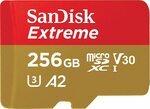As per title, currently NZD54.63 shipped from amazon AU vs. NL CSC discount price $125.99
SanDisk Extreme 256GB MicroSD A2, U3, V30 NZ$54.63 Shipped @ Amazon AU
Last edited 08/06/2022 - 16:19 by 2 other users
 CamelCamelCamel.
CamelCamelCamel.Related Stores
closed Comments

Memory cards price here in NZ is a joke.

(insert product name) price here in NZ is a joke

FYI, Noel L has SanDisk 256GB Ultra MicroSD A1 (lower rated MicroSD) for $49.20 via CSCBG Premium pricing, down from $129.90.

Shows how normal shoppers getting fleeced

Even though they marketed for gaming, are these okay for using in dash cams or GoPros?

Thanks

yes, i use one for my gopro.

There's a similar Samsung one with the same A2 / U3 / V30 / XC I rating for AU $8.91 less. Is it comparable, or is the SanDisk significantly better?
https://www.amazon.com.au/Samsung-Memory-Adapter-Limited-War…

Was just looking at that.
Basically those ratings mean they meet the spec, but they're not meaningful when the cards go beyond the spec.
EG back in the day the maximum rating was simply Class 10, which meant they could read 10MB/s. Except after a year or two those SD cards could knock out 30-70MB/s reads.
So two cards could have the same rating, but one with 70MB reads and the other with 30MB reads, of course the former was significantly better, but the average consumer had no way of knowing that.
These days they can be easily over a hundred MB read/writes.
Now there's a bunch more ratings, but that doesn't necessarily mean they're the same. EG the Samsung Pro Plus is 50% more expensive than the Samsung Evo Plus, but the ratings are the same. It's unlikely they're identical cards.
Finally:
It also depends on what you're going to be using it for.ARM MicroPC with Linux installed:
Performance will matter to you. Heaps of random IOPS in accessing the tiny files all over the place.Phone Storage:
Won't really matter, secondary Android storage is almost always just apps and media. A faster random read might make an app load SLIGHTLY faster, but they tend to be pretty small applications, so it's unlikely you'll notice.Photography:
It'll be completely meaningless.Videography:
If you don't know whether it matters, it likely won't matter.Portable Storage (eg instead of a USB flash drive):
Want as fast sequential as possibleComputer OS (SD card slot on a server):
Want as fast random as possible, which is a less common test.I'm just going to buy one each and test them out for fun. I could use the storage, and would be useful to use the SD card slot on a server I'm planning to buy rather than try and carve up my 3.5" HDDs for OS.

Just bought one each, I'll let you know how they go.

They've just arrived.
Using CrystalDiskMark.
5 passes
32GiB
Sequential = Good for videos and raw photos, large files accessed sequentially
Random = Good for everything else (portable storage, apps, operating systems like a Pi etc), small files accessed all over the place
QD = Queue Depth, the number of files lined up to be processed. The more files are queued, the easier it is to move onto the next file and some preprocessing can be done.
EG
QD1 Send one file. Once it completes the queue. Start a new one with just one file.
QD32 Send 32 files, which are queued waiting to be processed back to back.SanDisk Extreme A2 256GB
Seq Read (QD8): 92.78MB/s
Seq Read (QD1): 89.39MB/sSeq Write (QD8): 85.12MB/s
Seq Write (QD1) : 80.38MB/sRandom Read (QD32): 3.77MB/s
Random Read (QD1): 2.68MB/sRandom Write (QD32): 1.55MB/s
Random Write (QD1): 1.41MB/sSamsung Evo Plus A2 256GB
Seq Read (QD8): 93.27MB/s
Seq Read (QD1): 89.69MB/sSeq Write (QD8): 83.02MB/s
Seq Write (QD1) : 81.18MB/sRandom Read (QD32): 11.25MB/s
Random Read (QD1): 10.62MB/sRandom Write (QD32): 2.96MB/s
Random Write (QD1): 2.98MB/sConclusion:
The cheaper Samsung EVO is a significantly better card. It's basically identical in sequential, so for photos and videos it won't matter which you go for. Seeing as the Samsung was cheaper, it's an obvious win.But for everything else it is at least twice as good on writes, and three times as good on reads, for less money.

Videography:
If you don't know whether it matters, it likely won't matter.Brutal but true 😂
If you’re running higher end GoPros and specifically have higher bit rate modes enabled, then fast write times are super important.The photography one is the same as the video though, as it can apply in some circumstances.
If you’re into any sports or birding with fast bursts en clearing that buffer quickly is super important to be ready to go again. Requires a camera that can support higher spec card interfaces anyway though.

If anyone has a drone. What memory would you recommend? Thanks

Just realized that you can now choose NZD as the preferred currency on Amazon AU

That's something new. Thanks. Though you can't still pay in NZD.


That's cheap!